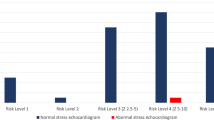Abstract
Multiple cardiovascular sequelae have been reported late after Kawasaki disease (KD), especially in patients with coronary artery lesions. In this perspective, we hypothesized that exercise response was altered after KD in patients with coronary aneurysms (CAA-KD) compared to those without history of coronary aneurysms (NS-KD). This study is a post hoc analysis of exercise data from an international multicenter trial. A group of 133 CAA-KD subjects was compared to a group of 117 NS-KD subjects. Subjects underwent a Bruce treadmill test followed to maximal exertion. Heart rate (HR), systolic blood pressure (SBP), and diastolic blood pressure (DBP) were assessed at each stage of the test including recovery. Myocardial perfusion was evaluated by stress and rest Tc-99m sestamibi SPECT imaging. Endurance time was similar between NS-KD and CAA-KD (11.3 ± 2.6 vs. 11.0 ± 2.6 min; p = 0.343). HR, SBP, and DBP responses to exercise were similar between groups (p = 0.075–0.942). Myocardial perfusion defects were present in 16.5 % CAA-KD versus 22.2 % NS-KD (p = 0.255). Analysis based on myocardial perfusion status identified a lower heart rate at 1 min into recovery as well as lower DBP at 1 and 5 min into recovery in patients with abnormal SPECT imaging (p = 0.017–0.042). Compared to patients without CA involvement, the presence of coronary aneurysms at the subacute phase of KD does not induce a differential effect on exercise parameters. In contrast, exercise-induced myocardial perfusion defect late after the onset of KD correlates with abnormal recovery parameters.

Similar content being viewed by others
References
Allen SW, Shaffer EM, Harrigan LA, Wolfe RR, Glode MP, Wiggins JW (1992) Maximal voluntary work and cardiorespiratory fitness in patients who have had Kawasaki syndrome. J Pediatr 121(2):221–225
Chatrath R, Shenoy R, Serratto M, Thoele DG (2002) Physical fitness of urban American children. Pediatr Cardiol 23(6):608–612
Comarmond C, Dessault O et al (2013) Myocardial perfusion imaging in Takayasu arteritis. J Rheumatol 40(12):2052–2060
Dahdah N, Fournier A (2013) Natriuretic peptides in Kawasaki disease: the myocardial perspective. Diagnostics 3(1):1–12
de Onis M, Garza C, Victora C, Bhan MK, Norum K (2004) The WHO multicentre growth reference study (MGRS): rationale, planning, and implementation. Food Nutr Bull 25(S1):S3–S84
de Onis M, Onyango AW, Borghi E, Siyam A, Nishida C, Siekmann J (2007) Development of a WHO growth reference for school-aged children and adolescents. Bull World Health Organ 85(9):660–667
Furuyama H, Odagawa Y et al (2003) Altered myocardial flow reserve and endothelial function late after Kawasaki disease. J Pediatr 142(2):149–154
Ghelani SJ, Singh S, Manojkumar R (2009) Endothelial dysfunction in a cohort of North Indian children with Kawasaki disease without overt coronary artery involvement. J Cardiol 53(2):226–231
Gravel H, Dahdah N, Fournier A, Mathieu ME, Curnier D (2012) Ventricular repolarisation during exercise challenge occurring late after Kawasaki disease. Pediatr Cardiol 33(5):728–734
Kashyap R, Mittal BR, Bhattacharya A, Manojkumar R, Singh S (2011) Exercise myocardial perfusion imaging to evaluate inducible ischaemia in children with Kawasaki disease. Nucl Med Commun 32(2):137–141
Kato H, Sugimura T et al (1996) Long-term consequences of Kawasaki disease. A 10- to 21-year follow-up study of 594 patients. Circulation 94(6):1379–1385
Kondo C (2004) Myocardial perfusion imaging in pediatric cardiology. Ann Nucl Med 18(7):551–561
Lewis G, Gona P et al (2008) Exercise blood pressure and the risk of incident cardiovascular disease (from the Framingham Heart Study). Am J Cardiol 101(11):1614–1620
Maddox TM, Ross C et al (2008) The prognostic importance of abnormal heart rate recovery and chronotropic response among exercise treadmill test patients. Am Heart J 156(4):736–744
Newburger J, Fulton D (2004) Kawasaki disease. Curr Opin Pediatr 16(5):508–514
Newburger J, Takahashi M et al (2004) Diagnosis, treatment, and long-term management of Kawasaki disease: a statement for health professionals from the Committee on Rheumatic Fever, Endocarditis, and Kawasaki Disease, Council on Cardiovascular Disease in the Young, American Heart Association. Pediatrics 114(6):1708–1733
Noto N, Okada T et al (2009) Age-related acceleration of endothelial dysfunction and subclinical atherosclerosis in subjects with coronary artery lesions after Kawasaki disease. Pediatr Cardiol 30(3):262–268
Paridon SM, Galioto FM, Vincent JA, Tomassoni TL, Sullivan NM, Bricker JT (1995) Exercise capacity and incidence of myocardial perfusion defects after Kawasaki disease in children and adolescents. J Am Coll Cardiol 25(6):1420–1424
Rhodes J, Hijazi ZM, Marx GR, Fulton DR (1996) Aerobic exercise function of patients with persistent coronary artery aneurysms secondary to Kawasaki disease. Pediatr Cardiol 17(4):226–230
Robinson B, Goudie B, Remmert J, Gidding SS (2012) Usefulness of myocardial perfusion imaging with exercise testing in children. Pediatr Cardiol 33(7):1061–1068
Singh JP, Larson MG et al (1999) Blood pressure response during treadmill testing as a risk factor for new-onset hypertension. The Framingham heart study. Circulation 99(14):1831–1836
Taillefer R, Ahlberg A et al (2003) Acute beta-blockade reduces the extent and severity of myocardial perfusion defects with dipyridamole Tc-99m sestamibi SPECT imaging. J Am Coll Cardiol 42(8):1475–1483
Tsuda E, Kamiya T, Ono Y, Kimura K, Kurosaki K, Echigo S (2005) Incidence of stenotic lesions predicted by acute phase changes in coronary arterial diameter during Kawasaki disease. Pediatr Cardiol 26(1):73–79
Weiss SA, Blumenthal RS, Sharrett AR, Redberg RF, Mora S (2010) Exercise blood pressure and future cardiovascular death in asymptomatic individuals. Circulation 121(19):2109–2116
Zanon G, Zucchetta P, Varnier M, Vittadello F, Milanesi O, Zulian F (2009) Do Kawasaki disease patients without coronary artery abnormalities need a long-term follow-up? A myocardial single-photon emission computed tomography pilot study. J Paediatr Child Health 45(7–8):419–424
Acknowledgments
Our gratitude is to Lantheus Medical Imaging inc., for allowing us to perform the analysis and to generate this manuscript. The authors also thank the international investigators who enrolled patients in the Cardiolite-301 study.
Author information
Authors and Affiliations
Corresponding author
Rights and permissions
About this article
Cite this article
Gravel, H., Curnier, D., Dallaire, F. et al. Cardiovascular Response to Exercise Testing in Children and Adolescents Late After Kawasaki Disease According to Coronary Condition Upon Onset. Pediatr Cardiol 36, 1458–1464 (2015). https://doi.org/10.1007/s00246-015-1186-5
Received:
Accepted:
Published:
Issue Date:
DOI: https://doi.org/10.1007/s00246-015-1186-5




